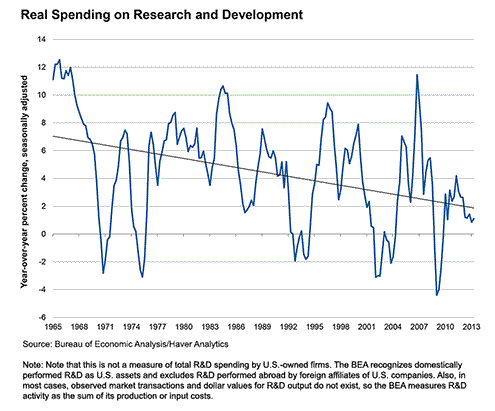In case you need more to worry about, try this: the pace of research and development (R&D) spending has slowed. The National Science Foundation defines R&D as “creative work undertaken on a systematic basis in order to increase the stock of knowledge” and application of this knowledge toward new applications. (The Bureau of Economic Analysis (BEA) used to treat R&D as an intermediate input in current production. But the latest benchmark revision of the national accounts recorded R&D spending as business investment expenditure. See here for an interesting implication of this change.)
The following chart shows the BEA data on total real private R&D investment spending (purchased or performed on own-account) over the last 50 years, on a year-over-year percent change basis. (For a snapshot of R&D spending across states in 2007, see here.)

Notice the unusually slow pace of R&D spending in recent years. The 50-year average is 4.6 percent. The average over the last 5 years is 1.1 percent. This slower pace of spending has potentially important implications for overall productivity growth, which has also been below historic norms in recent years.
R&D spending is often cited as an important source of productivity growth within a firm, especially in terms of product innovation. But R&D is also an inherently risky endeavor, since the outcome is quite uncertain. So to the extent that economic and policy uncertainty has helped make businesses more cautious in recent years, a slow pace of R&D spending is not surprising. On top of that, the federal funding of R&D activity remains under significant budget pressure. See, for example, here.
So you can add R&D spending to the list of things that seem to be moving more slowly than normal. Or should we think of it as normal?
- Bulenox: Get 45% to 91% OFF ... Use Discount Code: UNO
- Risk Our Money Not Yours | Get 50% to 90% OFF ... Use Discount Code: MMBVBKSM
Disclaimer: This page contains affiliate links. If you choose to make a purchase after clicking a link, we may receive a commission at no additional cost to you. Thank you for your support!


Leave a Reply